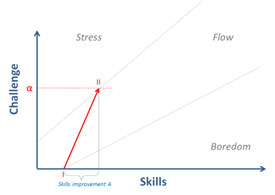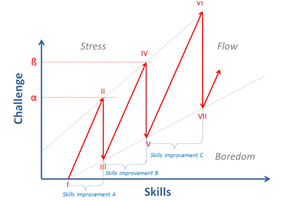By: Bengt Järrehult
An important topic in Innovation Management is that of motivation. What kind of incentives can an organization provide to stimulate innovation? Bengt Järrehult argues that there is no such thing as extrinsic motivation and we should really concern ourselves with working in Flow.
Incentives for innovation is a hot issue. Personally I am of the opinion that we cannot distinguish between intrinsic and extrinsic motivation for innovation, simply because there is no such thing as extrinsic motivation. When we refer to extrinsic motivation in the form of monetary rewards, for example “if you do this – you will get that much” we are simply talking about replacement for real motivation, and that is intrinsic motivation – the joy we feel when seeing our dreams come true – also called Flow. Today I will dwell a bit more on what Flow is and how it can affect your attitude towards work. For those especially interested in this topic – look for the books Creativity & Flow by Mihalyi Csikszenmihalyi and The Box by Micael Dahlén.

Imagine you have two parameters – the Challenge of the task you are given and the Skills you possess. Put them into a figure as the one above. There are now 2 areas you should avoid. One upper left, the Stress area, where the challenge is too high compared to your skills and one lower right, the Boredom area, where the challenge is too low compared to your skills. The area in the middle, called the Flow Area, is a very pleasant place where you might find that the perception of time just disappears when you work. You are really triggered by what you do and you notice you increase your mastery, one of the 3 main motivators according to Dan Pink in his book Drive (the others being autonomy and purpose).

How to get there? Well, you start at a position I where the challenge level α of the task you have may be a bit too high compared to your current skill level, but you still eagerly and a bit nervously start to work. Will you make it or not? As you learn by doing, you ideally reach your target II just before you reach the stress area. You feel rewarded because you have been working all the time in the pleasant Flow area and you now have reached your goal. The reward is, apart from the goal satisfaction, that you have improved your skills and learned a lot making you even better fit for your next challenge. Having finalized your first task coming from I to II, you now get a new task at III with an even higher challenge level, ß, than before. You start working and complete your task at IV. The sequence is repeating itself and you continuously improve your skills with each new task. It might even be that the Skills improvement (= Mastery) increase each time as A < B < C.

Being in the Flow area is, I think, the best reward you can get for what you are doing and it seems that the closer you are to the stress area, the more rewarding you feel it is. However, be well aware of the signals your body is telling you when you reach the Stress area. You might visit this area occasionally – but ensure you are not there longer periods. These warning signals could be:
- You wake up at 04:30 a.m., can’t fall asleep again….. and you think of issues in your job,
- You get a pain between your shoulders (due to tense muscles),
- You get stomach pain or you get easily irritated.
What you can do is to find out what your warning signals are, and in what order they come, to keep yourself within the Flow area, not staying in the Stress area for too long. Back off in time. If you reach the Boredom area, it is up to you to look for a better challenge as soon as possible. You are in charge!
By Bengt Järrehult
» Download a PowerPoint Presentation for this blog!
About the author
 Bengt Järrehult is Fellow Scientist Innovation at SCA, a global hygiene products and paper company. He is also adjunct professor and visiting professor resp. at 2 departments of Lund University in Sweden. He is an avid reader of and presenter on the topics of innovation, especially on breakthrough innovation and the psychological hurdles that exist to achieve this, hurdles that we may or may not be aware of. He is of the opinion that most companies more or less know what to do to become more innovative. What they don’t know is what really hinders them from doing these measures…
Bengt Järrehult is Fellow Scientist Innovation at SCA, a global hygiene products and paper company. He is also adjunct professor and visiting professor resp. at 2 departments of Lund University in Sweden. He is an avid reader of and presenter on the topics of innovation, especially on breakthrough innovation and the psychological hurdles that exist to achieve this, hurdles that we may or may not be aware of. He is of the opinion that most companies more or less know what to do to become more innovative. What they don’t know is what really hinders them from doing these measures…
